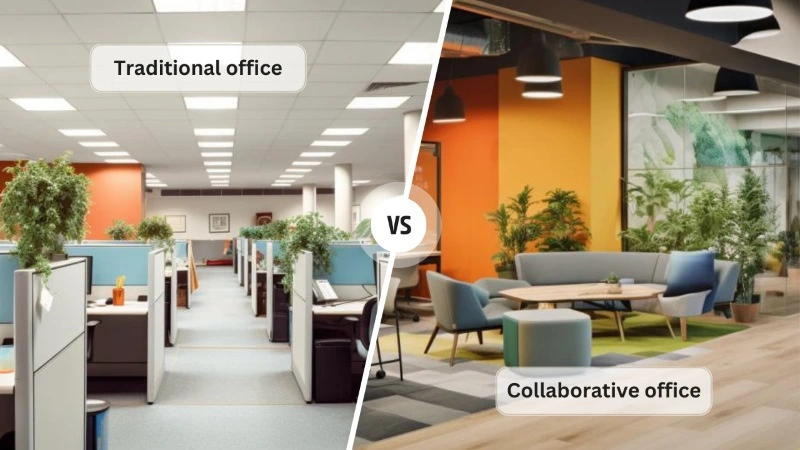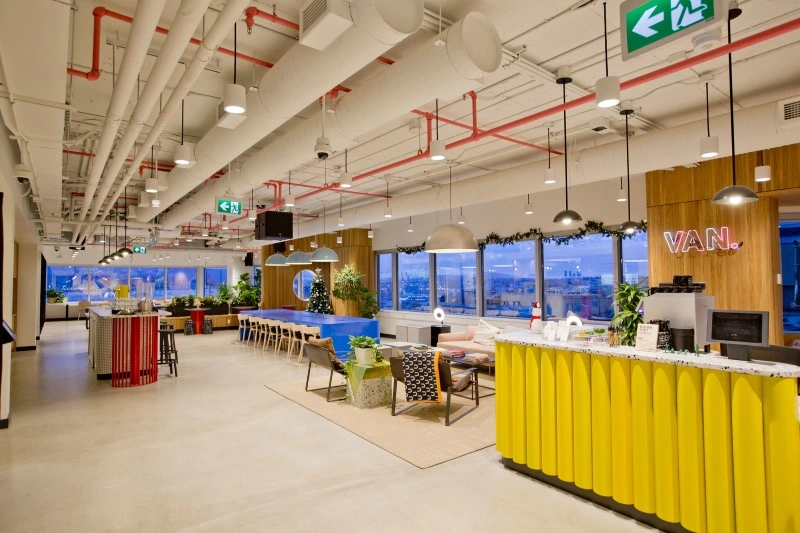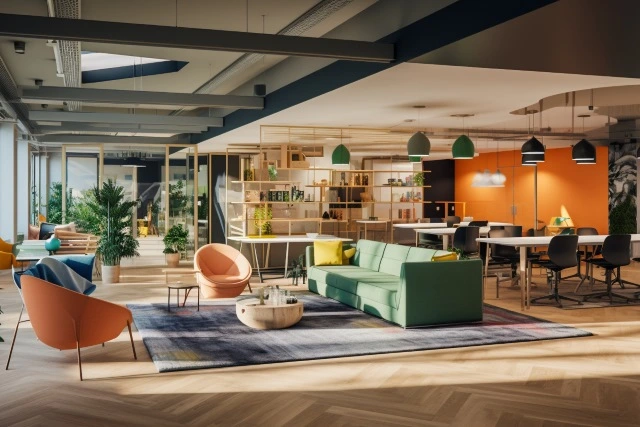After the COVID-19 quarantines, workplaces changed forever. We went from stuffed cubicles that prioritized efficiency above all else. This quickly changed when employers were forced to provide new remote working capabilities that evolved into the hybrid work environments of today. An employee’s in-office days are reserved for collaborative work requiring in-person interaction. As a result, collaborative workspaces are becoming the new norm with the flexibility they offer to accommodate hybrid work and features that encourage collaboration.
Embracing the collaborative workspace concept
In today’s business climate, where hybrid work models have become the norm, the need for collaborative workspaces has never been more pressing. This means businesses look for office space, allowing multiple employees to share a joint workspace easily. Collaborative workspaces fit these needs by allowing employees to work more freely in an office setting, removing the need for any individual employee to require a specified space.
What is meant by it and why does it matter in CRE?

At its core, a collaborative workspace is designed to foster teamwork and innovation. It uses a flexible design to encourage employee collaboration with shared resources. These spaces usually include open floor plans, communal tables, private meeting rooms, lounge areas, and recreational spaces. All rooms are designed to break down the traditional barriers to communication and collaboration.
This isn’t just a passing trend for the commercial real estate sector – it’s a transformative movement. Collaborative workspaces appeal to a wide audience, from freelancers hungry for interaction to corporations seeking to infuse their culture with creativity. This broad appeal is a boon for CRE, as it translates to lower vacancy rates and the potential for higher returns on investment. And it’s more than just a theory with nearly three-quarters of all coworking spaces reaching profitability after just two years.
Positive effects of a shared workspace solution
Shared workspace solutions can inject a new vitality into the working environment. Here are a few ways shared workspaces contribute to stronger work environments:
- Collaboration and networking: Shared spaces naturally foster interactions and connections between all occupants of a building.
- Flexibility and scalability: Businesses can easily scale up or down, thanks to flexible lease terms and various membership options.
- Cost efficiency: Startups and small businesses, in particular, can benefit from shared services and amenities, reducing the overhead that comes with private office spaces.
- Creativity and innovation: The dynamic atmosphere of a shared workspace can inspire creativity and lead to innovative ideas and solutions.
- Access to new markets: Companies can test the waters in new locations without the commitment of traditional office spaces.
- Sustainability: Shared resources and amenities mean a smaller environmental footprint than traditional office setups.
How commercial real estate can benefit from it
For property owners and managers, shared workspaces mean more than just full occupancy; they represent a strategic advantage. These spaces often offer a mix of memberships and leasing options, allowing for a diversified income stream that can be more resilient to market changes.
Additionally, the shared workspace model can increase tenant retention since it accommodates growing companies. As a company grows, it can easily upgrade its memberships or take on additional services instead of finding a new office building. This is shown in the number too with about 65% of coworking spaces being used by startups and SMEs.
Exemplary examples of real-world collaborative workspaces

Photo credit: CC BY 2.0 DEED by GoToVan
WeWork has become synonymous with the shared workspace concept, providing flexible office solutions that cater to everyone from freelancers to Fortune 500 companies. Their spaces are known for their stylish interiors, robust community events, and plug-and-play office infrastructure that create a great tenant experience.
Another trailblazer, The Wing, offers a women-focused collaborative workspace, aiming to empower its members with beautiful workspaces and a strong support network. Their focus on creating a space for connection and growth has carved out a unique niche in the shared workspace sector.
On a larger scale, Google Campus locations around the world are not just offices for Google employees. They often include coworking areas for local startups and entrepreneurs, fostering an ecosystem of innovation and collaboration. The design of these spaces encourages chance encounters and dynamic brainstorming sessions.
The role of digital tools and PropTech in enhancing collaboration
Digital tools and Property Technology (PropTech) play a pivotal role in enhancing collaboration. These tools not only streamline the management of shared workspaces but also significantly improve the user experience.
Investing in the right technology for your business
To fully harness the benefits of shared workspaces, CRE businesses need to invest in the technology that their tenants expect such as:
- Space booking systems: Seamless booking of meeting rooms, desks, and other resources, preventing double bookings and optimizing space usage.
- Real-time locators: Technologies that allow employees to find their colleagues quickly, which is invaluable in large or distributed offices.
- Desk management: Enabling hot-desking or hoteling with ease, ensuring that employees can find and reserve workstations that meet their needs.
- Equipment tracking: Systems that help locate essential equipment such as projectors, whiteboards, or conferencing gear, ensuring resources are available when needed.
- Environmental monitoring: Tools to oversee and adjust lighting, temperature, and air quality, providing a comfortable and productive work environment.
Modern platforms like ProptechOS partners Flowscape combine these solutions into a visual interface. This gives you and your tenants an intuitive overview of the workspace and its use. Users can easily interact with the visual interface to quickly book rooms, find their colleagues, or track down a piece of equipment they need.
Designing collaborative workspaces for the future
Collaborative workspaces typically have a few key design elements that allow for spontaneous group work without interrupting other tenants including:
- Modular furniture and configurable spaces: To accommodate different group sizes and types of collaborative work, from impromptu brainstorming sessions to formal presentations.
- Interactive displays and smart boards: Enabling real-time collaboration and idea sharing, both for teams in the space and those joining virtually.
- Acoustic design: High-tech soundproofing and noise-canceling systems ensure that teams can collaborate without disturbing others.
- Customizable workspace environments: Using technology to allow workers to customize their immediate environment, from adjustable desk heights to personal climate control.
Get started designing a collaborative workspace in your CRE building with the help of ProptechOS and its partners. Integrating all of your PropTech solutions into a unified environment can help you accommodate the growing trend of collaborative workspaces. This integration allows you to manage memberships, bill accordingly, and offer the resources collaborative workspace tenants expect.
Whether dedicating a single floor in a 10-story office building to collaborative work or turning a warehouse into a campus for collaboration, ProptechOS can help you turn any CRE space into a profitable collaborative workspace. Try ProptechOS for free today!

Dr. Erik Wallin
Chief Ecosystem Officer, and founder of ProptechOS and RealEstateCore is recognized as a leader in Building Operating Systems (BOS) and making the buildings of the world smarter. He holds an MSc and a Ph.D. in Media and Computer Science from KTH Royal Institute of Technology.
Read his full bio and information here.

